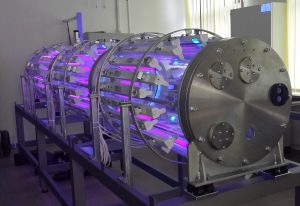
Environmental Simulation Chamber made of Quartz (ESCQ)
The 780L Atmosphere Simulation Chamber is an aggregate consisting of 3 quartz tubes in which gaseous-state experiments are performed for developing reaction mechanisms or kinetic studies.
The assembly allows a maximum working pressure of 1.2 bar and a vacuum of 10-3 mbar. The ESCQ is equipped with a multiple-reflection White mirror system (with a maximum optical path of 492 m) and is coupled with a VERTEX 80 Bruker FT-IR Spectrometer, enabling the in-situ investigation of reactants and products.
The frontal and terminal flanges are fitted with reactants and gases inlets as well as temperature, humidity, and pressure sensors. Several analytical systems are connected to the ESCQ for monitoring other parameters: actinometers – J(O3), J(O1D) and J(NO2). An air drying and purification system is used for ESCQ filling the chamber and cleaning, especially for NOy type and non-methanic compounds removal.
The specific UV (λmax=254 nm – germicidal) and VIS (λmax=365 nm – black-light) lamps provide uniform lighting of the quartz tubes exterior due to coaxial geometrical arrangement along the entire length and surface of the tubes.
The Vertex-80 FT-IR Spectrophotometer enables the investigation of the 8000-350 cm-1 wavelength domain. The Au-plated Michelson interferometer allows the maximum energy transfer. The UltraScan interferometer with active alignment is equipped with HeNe 632,8 nm and 5 mW laser. The instrument is equipped with KBr window (7500-350 cm-1) and achieves 0.2 cm-1 resolution and 0.01 cm-1 wavelength selection accuracy at 2000 cm-1. The instrument operation and spectra recording and processing is performed using the OPUS Software.
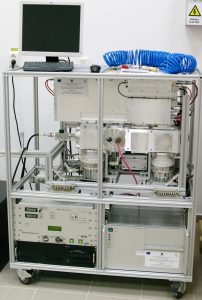
Aerodyne Aerosol Mass Spectrometer, HR-ToF-AMS, Aerodyne Research, USA
The Aerodyne Aerosol Mass Spectrometer (AMS) system is a state-of-the-art instrument, unique due to its characteristics as quantitative sampling capabilities, chemical analysis, and particle size discrimination of the aerosols. It can be used for both laboratory and field measurements and is capable of time-resolutions and generates real-time results.
The instrument can be used for trace analysis, chemical analysis by thermal evaporation and electron impact ionization – mass spectrometry. The sampling is possible for aerosol particles with the diameter in the range 0.04 up to 1.0 µm. The particles are collected in a high-vacuum system, followed by an aerodynamically focusing to a narrower beam (~1 mm in diameter) and directed to a heated surface where the volatile and semi-volatile chemical components are thermically vaporized and detected by an electron impact ionization quadrupole type mass spectrometer (70 eV).
The particles aerodynamic diameter is determined by measuring the speed of these particles in a time-of-flight discriminator. In this way chemical species capable of evaporation in the range 200 – 900 oC (usually 600 oC) can be detected. In this range the majority of atmospheric compounds are includes, except the elemental carbon and crust oxides (dust). Some inorganic compounds (marine salts) require higher (than 900 oC) volatilization temperatures.
The instrument operation is possible for both “W” and “V” modes. In W mode, using the high-resolution MS-TOF system, elemental and compounds (for example PAHs) analysis is possible. The V operating mode is of low resolution but is characterized by increased sensibility for monodisperse particles (d>300 nm).
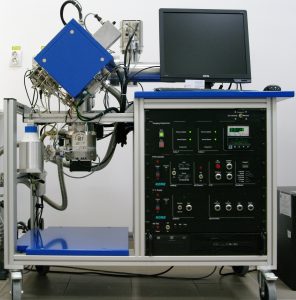
Proton Transfer Reaction – Mass Spectrometer, PTR-MS-TOF, KORE Technology, UK
The PTR-MS-TOF is capable of real-time quantitative and qualitative analysis of volatile organic compounds without any sample preparation and without using any carrier gas. The instrument can be used for environmental, food, air quality, medicine, biotechnologies, etc., studies.
The volatile organic compounds analysis is performed by using soft chemical ionization, the proton transfer reaction (PTR). This technique is dedicated to the compounds with affinity for protons greater than that of water. The instrument is designed for laboratory investigations, the open structure allowing the coupling with other analytical techniques like flux experiments in the simulation chamber, but it can also be used for dynamic field measurements, using in situ conditions.
The ionization is performed in a low-pressure reactor (0.1 – 2 mbar) in specific condition to avoid other molecules charging. The spectrometer’s sensibility is at least 200 CPS/ppbv for benzene and at least 300 CPS/ppbv for trichlorobenzene. The minimum resolution is 2000 m/Δm (FWHM). The operable mass range of the instrument is at least 1 – 50000 amu. The detection limit for benzene is 5 pptv, estimated as mean value for an integration time of 1 minute. The linearity is ensured at least for the 5 pptv – 10 ppmv domain.
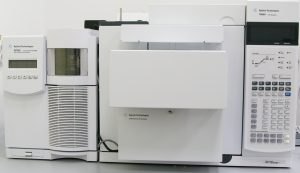
Gas Chromatograph with Flame Ionization Detector and Mass Spectrometer with Thermal Desorption GC-FID-MS-TDSG, GC Agilent 7890 GC – Agilent 240MS Ion Trap – Gerstel (Turbo)-TDSG-TDSA Thermal Desorption System, Agilent Technologies, USA
The instrument is designed for polar and non-polar, volatile and semi-volatile compounds analysis mostly from gaseous phase. The instrument is equipped with two detectors, the Flame Ionization Detector (FID) and Mass Spectrometer (MS). The GS – MS interface can be heated up to 350 oC with an independent thermal control system.
The Chromatograph ensures a retention time repeatability of <0,008% or <0,008 minutes and a peak aria repeatability of <1% RSD. The FID is specially optimized for capillary type columns and has a data acquisition speed of 500 Hz with minimum detected quantity of 1.8 pg Carbon/second and a maximum operating temperature of 450 oC. The MS/MS ion trap detector (5990-7664EN – Agilent 240 Ion Trap Mass Spectrometer) can be successfully used up to 1000 Da with the maximum scanning speed of 10000 Da/sec. The dual-filament electron impact ionization source ensures a maximum ionization time of 65 seconds. The MS is equipped with two ionization sources, Electron Impact (EI) and Chemical Ionization (CI). The SILCHROM-treated electrodes are characterized by maximum chemical inertia towards high mobility compounds or compounds with great affinity for surfaces.
The instrument is equipped with Gerstel Thermal Desorption System that is used for continuous monitoring of substances in air or gas fluxes by adsorption on proper materials, followed by thermic desorption, preconcentration and column injection, using a PTV-cooled injector. Both standard tubes thermal desorption or direct thermal extraction from solids and liquids operating conditions can be used and a new sample can be collected before completing the analysis of the previously collected sample.
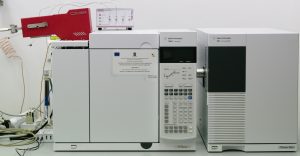
Gas Chromatograph with Flame Ionization Detector (FID) and Mass Spectrometer (MS) (GC×GC-FID-MS), GC Agilent 7890A – MS Agilent 5975C, Agilent Technologies, USA
The GC×GC-FID-MS System consists of Model 7890A Gas Chromatograph and a Model 5975C Mass Spectrometer, featuring double ionization (EI and CI). The Flame ionization Detector (FID) is specially optimized for capillary columns and has a data acquisition speed of 500 Hz and can detect a minimum of 1,8 pg C/sec, with a maximum operating temperature of 450 oC. The constant flow to the flame option is available, regardless of the column output, the flame extinction detection and reignition are automatically performed.
The 5975C MS XL EI/CI MSD Detector can be operated within the 1.5 to 150 amu range and both Chemical Ionization (CI) and Electron Impact (EI) operating modes can be used, with He or H2 as carrier gas and a dynamic operating mode up to 106. The hyperbolic shaped Quadrupole mass discriminator enhances the transmission efficiency and enables the achievement of high resolution without increasing the spectrometer’s optics complexity.
The instrument is intended for “comprehensive GC×GC” study of compound mixes. The second column can be independent thermally controlled and has a heating speed of 1800 oC/min. The instrument can be operated in the GC×GC-MS mode, without the use of cryogenic agents.
RTL Libraries, containing spectra, retention times, can be used for qualitative analysis of pesticides, allergens (at least 24), environmental volatile organic compounds (at least 65), PCB congeners (at least 209), compounds of interest for toxicology or forensics (at least 270), flavors (at least 400), common esters and fatty acids (at least 30).
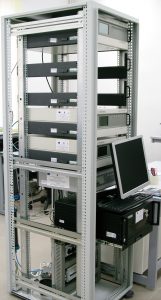
Air quality monitoring system, ECOTECH, Australia
The ECOTECH analyzers (monitors) aggregate consists of:
- Ozone analyzer, model O3 Ecotech EC 9810A,
- CO2 analyzer, model CO2 Ecotech EC 9820,
- CO analyzer, model CO Ecotech EC 9830A,
- NO/NO2 monitor, model NOx Ecotech EC 9841,
- SO2 analyzer, model SO2 Ecotech EC 9850,
- O3 generator, model Ecotech GasCal 1100TS.
The EC 9810A O3 analyzer uses a non-dispersive UV photometer principle and is equipped with a Mercury-vapor lamp, generating a central line at 240 nm, specific to the O3 absorption band. The O3 analyzer can be operated up to 20 ppm O3 and the detection limit is 2 ppb.
The CO2 analyzer uses a non-dispersive IR radiation technique, with gas filter correlation (GFC) technology, to accurately estimate the CO2 concentration in the ambiental air, with minimal interferences from CO and H2O. The CO2 analyzer can be operated up to 3000 ppm and detection limit is 2 ppb.
The CO, EC 9830A, analyzer uses a non-dispersive IR radiation technique, with real-time accurate and precise estimation of CO concentration in air. The instrument is auto-scalable and allows the CO analysis on at least two concentration ranges: “low concentration” – for values below 100 ppb and “high concentrations” for values below 200 ppm. The detection limit is 50 ppb.
The EC 9841A analyzer uses gaseous phase chemiluminescence detection for the analysis of NO, NO2, NOx. The instrument is fitted with a pneumatic system, NO2-NO converter, a reaction cell, a photomultiplier detector, and a processor. The analyzer is scalable and allows the nitrogen oxides (NO and NO2) estimation on two concentration domains: “low concentrations” up to 50 ppm and “high concentrations” up to 20 ppm. The detection limit is 0.5 ppb.
The SO2 EC 9850 Analyzer is a UV-Fluorescence Spectrometer designed for continuous low SO2 concentration measurements from air and is equipped with optical sensors, electric signal processor, a micro-processor, and a pneumatic system. The SO2 analyzer can be operated in two concentration domains, “low concentration” – up to 50 ppb and “high concentration” – up to 20 ppm, with the detection limit of 0.5 ppb when Kalman active filter is used.
The GasCal 1100TS O3 generator allows the generation and analysis of produced O3 and can be used for single or multiple points calibrations.
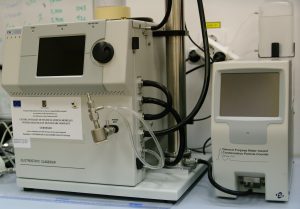
Scanning Mobility Particle Sizer (SMPS) for aerosols, with TSI 3080 Electrostatic Classifier & TSI 3787 Condensation Particle Counter, TSI, USA
The SMPS instrument can be used for aerosol determination in:
- material synthesis and nanotechnologies research,
- atmosphere study and monitoring,
- fuel and exhaust fumes studies,
- air quality measurements,
- toxic materials and pollutants studies.
The instrument is provided with specialized software and is used for aerosols (aerodynamic particles) classification, counting, volume and surface determinations.
The TSI 3080 Series Electrostatic Classifier is a standard primary instrument that is capable of sub-micrometrical sized monodispersed aerosol generation from a polydisperse source.
The instrument removes the polydisperse aerosols and, using a Differential Mobility Analyzer (DMA), classifies and narrows the sizes range to a well-defined domain. The SMPS instrument is a high-resolution equipment used for nanoparticles measurement and characterization, widely used for particle determination in air and suspensions. The SMPS Analyzer uses a discrete technique where the concentration is directly measured without shape or size discrimination. The method is highly precise and reproducible and is stable regardless of the refraction index variation of the particles/liquid.
The TSI 3787 Series Condensation Particle Counter (CPC) can be used for aerosol with dimensions as low as 2.5 nm quantification. The main advantages of this technique being:
- high-resolution data recording for up to 167 channels,
- wide dimensions range of 2.5 up to 1000 nm,
- wide concentrations domain of 1 to 107 particles/ cm3,
- fast measurements with particle distribution analysis in 15 to 30 seconds,
- automatic flow control for the aerosol-generating system,
- discrete particle measurement, especially advantageous for complex samples analysis, independent on the optical properties variation of the constituents,
- easy set-up and operation enable field measurements.

TGA-DSC/DTA Thermal Analysis System (STA F3 Jupiter), Netzsch, Germany, Coupled with FT-IR Spectrophotometer (Tensor 27), Bruker, Germany
The TGA-DSC/DTA Thermal Analysis System with gas investigation by Fourier Transform – IR Spectrometry (FT-IR) can be used for thermal behavior studios of ceramics, polymers, nanomaterials, alloys etc. at high temperatures.
Informations about aging, degradation, additivation processes can be obtained for raw or natural materials, synthesis products and chemical residues. The TG furnace, that is made of SiC, ensures an operating temperature range of 20 °C to 1500 °C.
The TGA System is simultaneously working with 3 gases, 2 for the purge and one as protective environment for the analytical balance, helping to achieve a resolution of 1 µg that is constant on the entire measuring domain.
The TG-DTA sample holder is fitted with a temperature sensor and can be operated on the 25-1550 oC range. Both Al2O3 and Pt/Ir variable volume crucibles can be used. A PTFE replaceable gas transfer line is fitted to the system and a thermostated, at least at 300°C, adapter ensures the gases transfer to the FT-IR Spectrophotometer.
The TGA-IR module is equipped with a stainless-steel optical cell with an optical path of 123 mm, allowing the investigation of the 8000-340 cm-1 spectral range. The instrument is equipped with a DLaTGS fitted with a temperature control Peltier system and a InGaAs detector.
